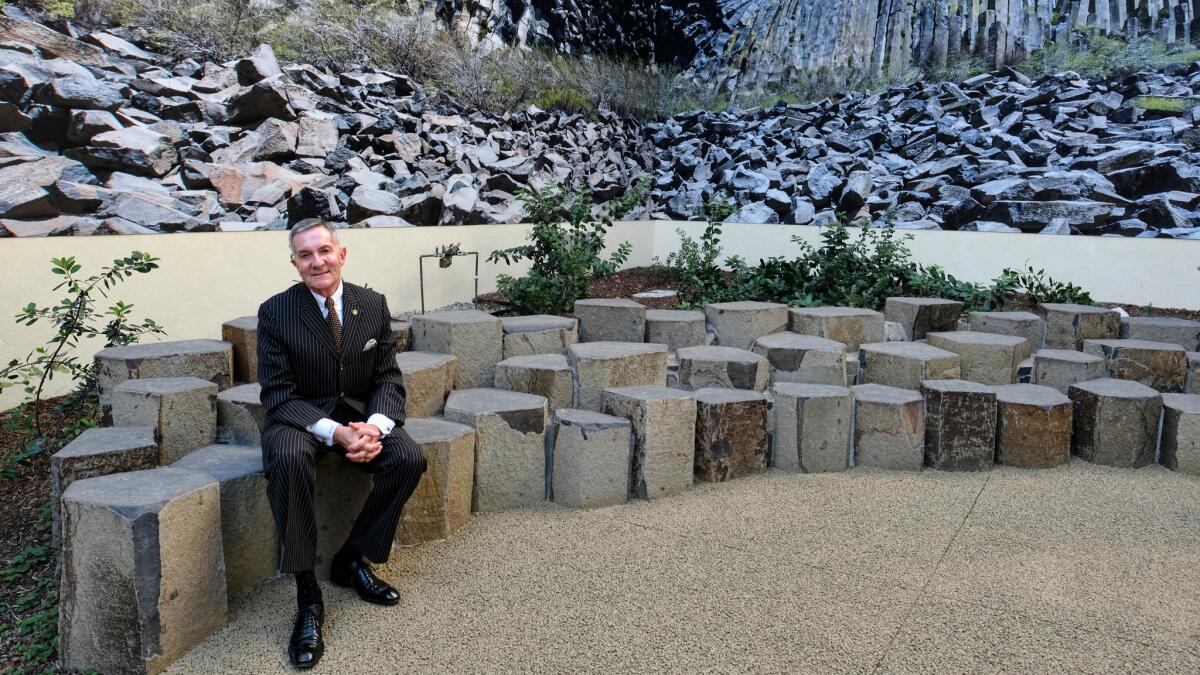The Autry Museum’s CEO is retiring. A UCLA historian will take over

The man credited for transforming L.A.’s Autry Museum of the American West and championing contemporary Native American artists has announced plans to retire.
President and Chief Executive W. Richard West Jr. will retire in June 2021, the museum said Tuesday. UCLA history professor emeritus Stephen Aron, who has a scholarly history with the Autry dating to 2002, will succeed him.
West, who is a citizen of the Cheyenne and Arapaho Tribes, has led the Autry since Jan. 1, 2013. Previously he was founding director of the Smithsonian’s National Museum of the American Indian in Washington, D.C., and prior to that he spent nearly 20 years as a Native rights attorney.
During his 7½-year tenure at the Autry, he is credited with transforming the institution founded as the Autry Museum of Western Heritage in 1988 by actor-cowboy Gene Autry and his wife, Jackie, along with another singing cowboy, Monte Hale, and his wife, Joanne.
The city’s streetlight design competition drew more than 100 entries. Did the right design win?
“My life as a director of museums is a double rainbow,” West said in an interview. “I’ve had the honor and the pleasure of directing two of the finest museums, but I made a vow to myself that I would not be directing a museum when I turned 80!”
West, 77, grew annual attendance at the Autry by more than 25%, to an average of nearly 200,000 visitors a year before the museum closed in March because of the pandemic. In 2015 he launched an $80-million fundraising campaign (of which $71 million has been raised so far) to expand exhibitions, programming and educational initiatives. West also grew the collection, adding about 3,600 items to what’s now more than 600,000 objects — art and artifacts as well as a library and archives that include rare books, old maps and sound recordings. In 2019 he oversaw completion of the Autry’s Resources Center, a collections, research and education facility in Burbank that will open to the public in early 2021.
West — who was born in San Bernardino and whose father was an artist — also shaped exhibitions and programming with an eye toward making the museum more relevant and diverse. That has included the Autry on the map as a destination for contemporary Native American art.
The museum has presented traveling exhibitions featuring contemporary artists including Rick Bartow and David Bradley. The museum’s group show “When I Remember I See Red: American Indian Art and Activism in California” will open virtually this fall.
West is particularly proud of the 2019 Autry-produced exhibition “Coyote Leaves the Res: the Art of Harry Fonseca,” centered on the California-born artist whose estate the museum acquired in 2016, and “La Raza,” the Autry’s 2017 offering for the Pacific Standard Time: LA/LA initiative organized by the Getty. “La Raza” was about a Chicano rights movement publication of the same name that was active from 1967 to 1977.
West diversified the Autry’s curatorial staff with the goal of expanding whose stories are told in the American West. This past December, the museum announced two high-profile hires: Minnesota-based curator Joe D. Horse Capture as vice president and curator, and California African American Museum curator Tyree A. Boyd-Pates as associate curator of Western history.
“Tyree and Joe, because of their own experiences and their own work,” West said, “will bring voices of the African American communities and the numerous contemporary native communities across the U.S. that then have impact on the life of the museum and making the museum a resource for those communities.”
West’s tenure at the Autry was not without its difficulties.
He inherited a controversial conversation over the future of the historic but financially troubled Southwest Museum of the American Indian, the 100-plus-year-old museum in Mt. Washington that is L.A.’s oldest. The Autry assumed ownership of it when the organizations merged in 2003. The Southwest Museum holds one of the country’s most important collections of indigenous art and artifacts, for which the Autry cares. But groups such as Friends of the Southwest Museum Coalition and residents of the area have argued that the shuttered 1914 building and grounds should reopen as a museum unto itself. The Autry has said the cost of updating and operating the building, including seismic structural improvements, would be prohibitive.
In Spring 2019, together with the National Trust for Historic Preservation, West began the complicated process of seeking to transfer ownership of the Southwest Museum. Conversations between the city, L.A. County and the Autry about the Southwest Museum’s future are still in progress.
The new SoFi Stadium will be home to the Rams and Chargers, but it holds the potential to be so much more to the communities around it.
In 2015 West changed the museum’s name from the Autry National Center of the American West — a name it had gone by since 2004, representing the Autry, the newly-acquired Southwest Museum and a new research arm, the Institute for the Study of the American West, for which Aron was founding executive director. Autry Museum of the American West was more streamlined and Google-friendly, whereas the old name, West told the Los Angeles Times in 2015, “is a bit of a misnomer and out of date.”
During the COVID-19 crisis and nationwide protests sparked by the killing of George Floyd, the Autry launched collecting initiatives to document the pandemic and the protests for future generations. Boyd-Pates is curating the “Collecting Community History Initiative: The West During Covid-19 and the Black Lives Matter Protests in the West,” acquiring and preserving ephemera — handwritten journals, photography, recipes, protest posters, face masks and other PPE — from this moment in history.
Aron, who joined UCLA’s history department in 1996, helped to secure a grant for the initiative from the UCLA History Department’s Luskin Center for History and Policy.
The project, Aron said in the announcement Tuesday, “exemplifies the ways in which Rick West and the Autry staff have tackled the diversity and complexity of the American West, blazing a trail that I intend to follow.”
West will stay on at the Autry for such an unusually long time, until next summer, because he feels it’s important to guide the museum through what he hopes is the worst of the pandemic.
In something of a programmatic exit ceremony, West will host a series of events, virtual to start, over the next year that touch on museum trends, COVID-19, and contemporary Native American art, among other topics.
“I have great confidence in Stephen Aron, I’m thrilled he’s my successor,” West said. “As for myself, I don’t play golf, I’m not heading in that direction. I’m still involved with a number of Native-connected or museum-connected organizations, and I will just continue to do these kinds of things, the elements that always inspired and drove me.”
Amy Sherald, who painted Michelle Obama for the National Portrait Gallery, conjures the slain young woman in a remarkable piece of art.
More to Read
The biggest entertainment stories
Get our big stories about Hollywood, film, television, music, arts, culture and more right in your inbox as soon as they publish.
You may occasionally receive promotional content from the Los Angeles Times.











